ASUS PN50 mini-PC Review: A Zen 2 Business NUC
by Ganesh T S on October 1, 2021 10:00 AM EST- Posted in
- Systems
- AMD
- Asus
- NUC
- UCFF
- Mini-PC
- Zen 2
- Ryzen Embedded
- Renoir
- Ryzen 4000
- Ryzen 7 4800U
UL Benchmarks: PCMark, 3DMark, & Storage
This section deals with a couple of UL Futuremark benchmarks - PCMark 10 and 3DMark. While PCMark evaluates the system as a whole, 3DMark focuses on the graphics capabilities with emphasis on gaming workloads.
PCMark 10
UL's PCMark 10 evaluates computing systems for various usage scenarios (generic / essential tasks such as web browsing and starting up applications, productivity tasks such as editing spreadsheets and documents, gaming, and digital content creation). We benchmarked select PCs with the PCMark 10 Extended profile and recorded the scores for various scenarios. These scores are heavily influenced by the CPU and GPU in the system, though the RAM and storage device also play a part. The power plan was set to Balanced for all the PCs while processing the PCMark 10 benchmark.
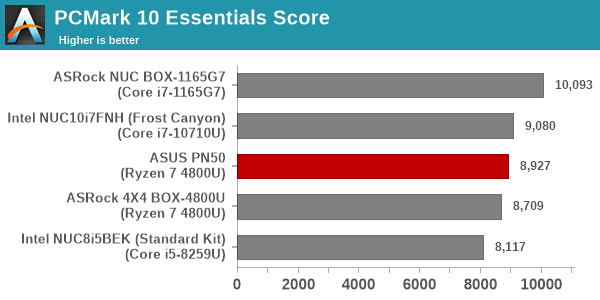
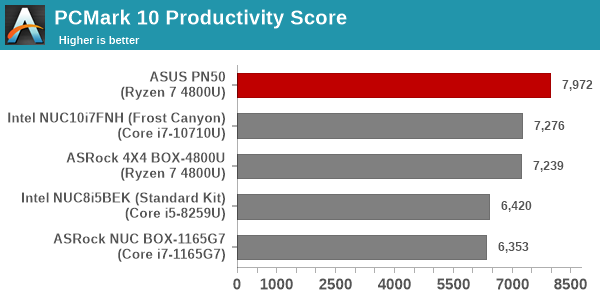

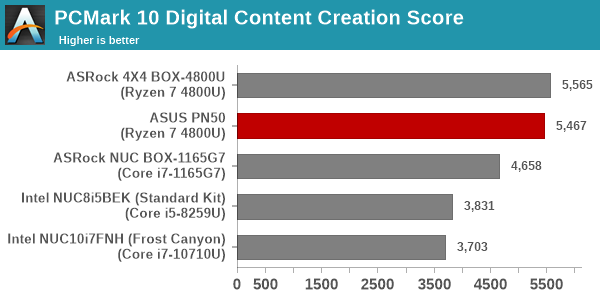
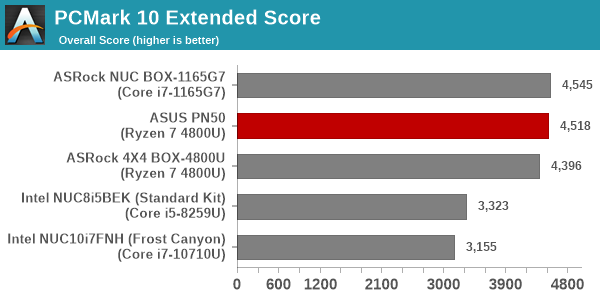
A comparative analysis of the scores reveals two important aspects - in productivity workloads, where multi-core performance plays a good part, the 8C/16T configuration of the PN50 helps it to surpass UCFF PCs like the NUC BOX-1165G7. However, when single-threaded performance matters, the Tiger Lake PC gets a healthy lead. On the graphics side, when compared to Frost Canyon and Bean Canyon NUCs, the Vega iGPU gets a handy lead. However, with Tiger Lake, Intel gets the graphics crown. When comparing the ASRock 4X4 BOX-4800U and the ASUS PN50, the latter has a slight edge (reasons for which will become clear in a later section).
PCMark 10 Storage
On the storage side, one option for evaluation would be repetition of our strenuous SSD review tests on the drive(s) in the PC. Thankfully, to avoid that overkill, UL's PCMark 10 has a Full System Drive Benchmark storage test certain common workloads such as booting, loading games, and document processing are replayed on the target drive. The average access times and bandwidth numbers are recorded for each trace and the overall numbers contribute to a benchmark score.
In case of single drive systems, we attempt to allocate 180GB to the primary partition, and leave the remaining space on the drive as a secondary partition.
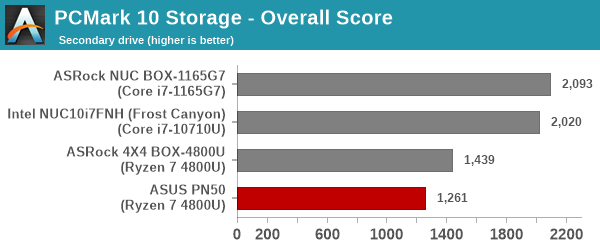
The ASUS PN50's 512GB Intel SSD 660p drive is based on QLC NAND, and can't keep up even with DRAM-less NVMe SSDs such as the Patriot P300 in the ASRock 4X4 BOX-4800U. There is no comparison to be made against the the PCIe 4.0 SSD (ADATA XPG GAMMIX S50 Lite) in the NUC BOX-1165G7, and the Crucial P5 in the Frost Canyon NUC, as seen in the above graph. On the plus side, this basic SSD brings down the cost of the system significantly.
3DMark
UL's 3DMark comes with a diverse set of graphics workloads that target different Direct3D feature levels. Correspondingly, the rendering resolutions are also different. We use 3DMark 2.4.4264 to get an idea of the graphics capabilities of the system. In this section, we take a look at the performance of the Asus PN50 across the different 3DMark workloads.
3DMark Ice Storm
This workload has three levels of varying complexity - the vanilla Ice Storm, Ice Storm Unlimited, and Ice Storm Extreme. It is a cross-platform benchmark (which means that the scores can be compared across different tablets and smartphones as well). All three use DirectX 11 (feature level 9) / OpenGL ES 2.0. While the Extreme renders at 1920 x 1080, the other two render at 1280 x 720. The graphs below present the various Ice Storm worloads' numbers for different systems that we have evaluated.
| UL 3DMark - Ice Storm Workloads | |||
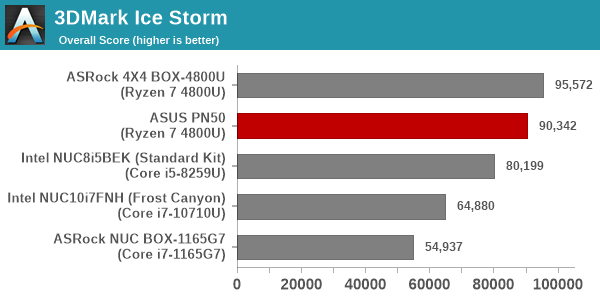
The 3DMark Ice Storm workloads show a win for the Vega iGPU across the board, even with the Tiger Lake iGPU in the picture. Between the ASRock and the ASUS units, most scores are within the margin of error of each other.
3DMark Cloud Gate
The Cloud Gate workload is meant for notebooks and typical home PCs, and uses DirectX 11 (feature level 10) to render frames at 1280 x 720. The graph below presents the overall score for the workload across all the systems that are being compared.
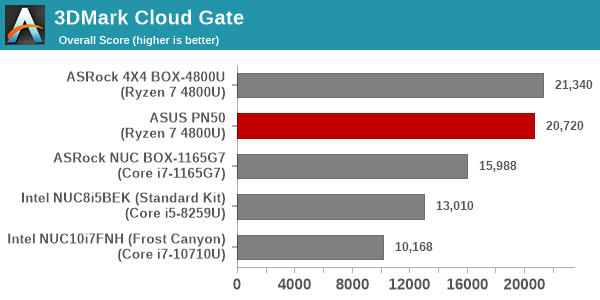
This low-stress workload is an easy win for the Vega iGPU, even though the Tiger Lake NUC BOX is able to put up a good showing compared to the Bean Canyon and Frost Canyon NUCs.
3DMark Fire Strike
The Fire Strike benchmark has three workloads. The base version is meant for high-performance gaming PCs. Similar to Sky Diver, it uses DirectX 11 (feature level 11) to render frames at 1920 x 1080. The Extreme version targets 1440p gaming requirements, while the Ultra version targets 4K gaming system, and renders at 3840 x 2160. The graph below presents the overall score for the Fire Strike Extreme and Fire Strike Ultra benchmark across all the systems that are being compared.
| UL 3DMark - Fire Strike Workloads | |||
For 1440p and higher resolution gaming performance targeted by this workload, the single-threaded performance of the Tiger Lake processor likely gives it the edge and a healthy score advantage over the 4800U in the ASUS PN50.
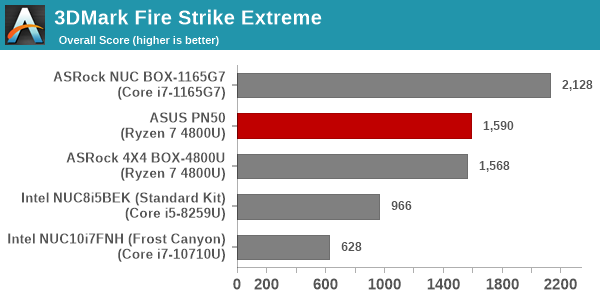
3DMark Time Spy
The Time Spy workload has two levels with different complexities. Both use DirectX 12 (feature level 11). However, the plain version targets high-performance gaming PCs with a 2560 x 1440 render resolution, while the Extreme version renders at 3840 x 2160 resolution. The graphs below present both numbers for all the systems that are being compared in this review.
| UL 3DMark - Time Spy Workloads | |||
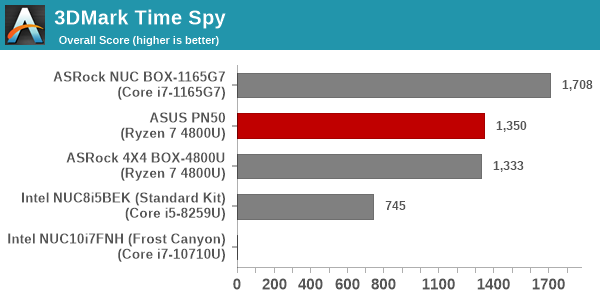
Similar to Fire Strike, the Time Spy workload also favors the Tiger Lake system over the ASUS PN50. This is likely due to the single-threaded performance edge of the Core i7-1165G7 over the PN50's Ryzen 7 4800U.
3DMark Night Raid
The Night Raid workload is a DirectX 12 benchmark test. It is less demanding than Time Spy, and is optimized for integrated graphics. The graph below presents the overall score in this workload for different system configurations.
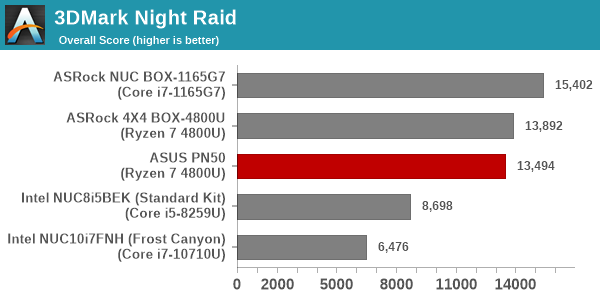
The ST performance advantage of the Tiger Lake processor gives the ASRock NUC BOX-1165G7 a slight edge in this benchmark geared towards integrated graphics. However, the gulf is not as wide as what was observed in the other benchmarks targeting graphics performance at 1440p+ resolutions.
3DMark CPU Profile Benchmark
UL recently introduced a benchmark to test the multi-threaded capabilities of the CPU in a system. Since gaming workloads are often multi-threaded, it makes sense to include this testing as part of the 3DMark suite. The benchmark routine attempts to perform the simulation of birds / bird-like objects flocking together using as many advanced capabilities as offered by the processor. The workload is configured to run with different number of threads ranging from 1 to 16 (and a single entry for the maximum number of threads allowed in the system).
| UL 3DMark - CPU Profile Benchmark | |||
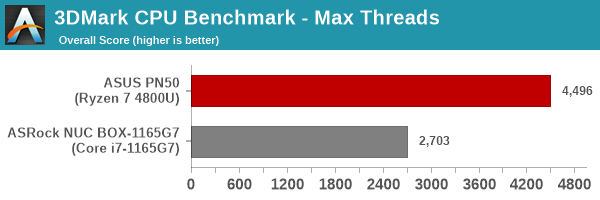
We present the benchmark results for the single and maximum threads case above. As expected the four extra cores in the Ryzen 7 4800U helps the ASUS PN50 score almost double that of the NUC BOX-1165G7 in the multi-threading case. However, the single threaded performance crown is retained by the Tiger Lake system.
Otherwise, as far as graphics performance and features are concerned, we opted not to process our regular HTPC workloads on the PN50, as the platform is already a known quantity with respect to suitability for such tasks. Hardware decode acceleration is available for all common codecs other than AV1.










32 Comments
View All Comments
meacupla - Friday, October 1, 2021 - link
I feel like, if Asus skipped the 2.5" SATA drive, they could have used a beefier heatsink to allow 25W operation with no thermal throttling.Integr8d - Friday, October 1, 2021 - link
I agree. The little fan would spin up that much less frequently. It's not bad though (and if I ran mine behind the monitor, I'm sure I'd never hear it).StevoLincolnite - Friday, October 1, 2021 - link
Not to mention a last gen Ryzen...Samus - Friday, October 1, 2021 - link
Agreed. They should at least consider a separate SKU that axes the 2.5" drive and slightly increases the heatsink surface area, as you said. This would cost almost nothing as a case rework wouldn't be necessary: all they need to change is the heatsink and perhaps the blower.YB1064 - Saturday, October 2, 2021 - link
Anemic 1GbE and a previous gen Ryzen...no thanks.dotjaz - Sunday, October 3, 2021 - link
PN50E1 has the 2.5GbE. As for lastgl gen APU, what's your point? 5000 series won't be much faster because it's still thermal limited.Samus - Monday, October 4, 2021 - link
Seriously like the Ryzen 4xxx-U's are slow or something...they're insanely fast.TheinsanegamerN - Thursday, October 7, 2021 - link
Just because they are fast doesnt mean people want to pay current gen pricing for a last gen product.powerarmour - Saturday, October 2, 2021 - link
It feels out of date already too, I'm not sure why anyone would want to buy this now.Oxford Guy - Saturday, October 2, 2021 - link
If companies don’t include egregious flaws how is there an incentive to upgrade sooner rather than later? Fix one flaw, get a new one.